Science behind Sp " Burgundy"
- Thread starter Fran
- Start date
- Joined
- Jul 31, 2007
- Messages
- 1,578
I don't have adult female T. blondi so I cannot answer that one. Once this male matures, I will have both species to compare the palpi emboli.
- Joined
- Jul 28, 2007
- Messages
- 1,139
I would wonder the same thing. It makes me wonder what differences are in each of the species spermathecae.what about the Spermathecae, are they the same???
- Joined
- Oct 22, 2009
- Messages
- 336
I can't wait for the paper to come out! This makes me wonder if the blondi I'm getting for my bday is a true blondi or the T. Sp.
- Joined
- Oct 1, 2009
- Messages
- 909
Following this!
Gives me yet another reason to not have a T.blondi though.
(I didn't really want one anyway, I already have an L.para to satisfy my need for giant T!)
Gives me yet another reason to not have a T.blondi though.
(I didn't really want one anyway, I already have an L.para to satisfy my need for giant T!)
- Joined
- Jul 31, 2007
- Messages
- 1,578
Since you're in America, I'll put money on it that you're getting T. sp. Compare it to the pic above and it will probably more closely resemble the T. sp. on the left.I can't wait for the paper to come out! This makes me wonder if the blondi I'm getting for my bday is a true blondi or the T. Sp.
- Joined
- Jan 25, 2007
- Messages
- 4,212
THIS is something i would consider very important. definitely a big key in distinguishing. if you could, i would even take a palp (or both) from each male and send it in to someone specialized who could take a look. many times, palpal structure is a key to separating species.I don't have adult female T. blondi so I cannot answer that one. Once this male matures, I will have both species to compare the palpi emboli.
while spermathecae is good (for females), the palpal emboli for males is better.
continue on everybody...
- Joined
- Dec 16, 2008
- Messages
- 256
so...
if it in fact it is a new species, the palp structure would have to be different, right?
yet the spermathecae does not differ... or does it?
To this, we add the physical differences and voila.
if it in fact it is a new species, the palp structure would have to be different, right?
yet the spermathecae does not differ... or does it?
To this, we add the physical differences and voila.
- Joined
- Jan 25, 2007
- Messages
- 4,212
the palp structure would almost certainly be different. in theory, so would the spermathecae, but sometimes it can be somewhat difficult to tell species apart from that (many can look similar).
and physical differences- the naked patella say quite a bit to me.
and physical differences- the naked patella say quite a bit to me.
- Joined
- Sep 22, 2008
- Messages
- 3,112
so heres a question.
at what size would you be able to determine what you have?
i have a T whatever right now that is a male(this much i know) its about 4 inches. i got it from "drachenjager" from his last sac. as with probly alot of people did. it had pink feet as well. but as of right now i i can tell if there will be hairs of the patella or not. here is a picture of it.
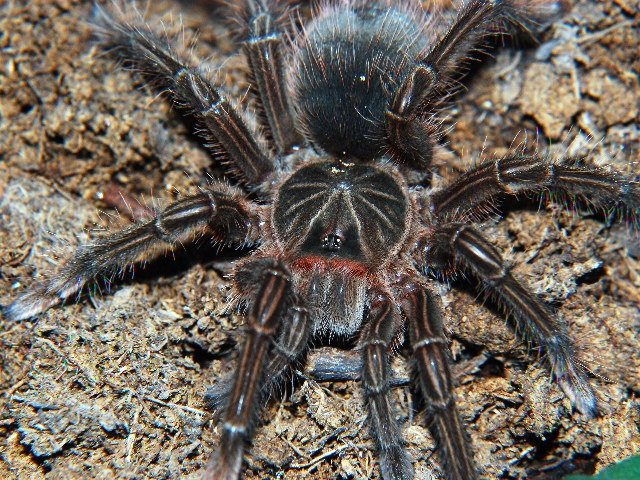
i can see what seems like bald patella on the front most legs but some of the rear legs have hair on them...:?
either way, this is an interesting thread that i am very interested in.
now i have to wait n 2 papers to come out(the revision on the Aphonopelma and now this.....)
at what size would you be able to determine what you have?
i have a T whatever right now that is a male(this much i know) its about 4 inches. i got it from "drachenjager" from his last sac. as with probly alot of people did. it had pink feet as well. but as of right now i i can tell if there will be hairs of the patella or not. here is a picture of it.

i can see what seems like bald patella on the front most legs but some of the rear legs have hair on them...:?
either way, this is an interesting thread that i am very interested in.
now i have to wait n 2 papers to come out(the revision on the Aphonopelma and now this.....)
- Joined
- Nov 21, 2009
- Messages
- 733
Different urticating hair types?
Xhexdx/Joe, Very good point/question. While I have never had experience with T. blondi, I see from the experience of most on the board that they have arguably some of the worst urticating hairs of any nw t's. My only spiders currently that bring about any reaction are my 2 boehmei- a rather mild but irritating itch at times. My hentzi years ago were slightly less troublesome but notable to some extent as well.
I was very tired when I last handled my Theraphosa. I had already showered when I pinch-grabbed her, kicking like mad, to get a look below. I took a nap afterward and realized much later on that I hadn't washed or even brushed my hands off before doing so. I remember my side itching briefly, then scratching it after dozing off. I was shocked once I was fully awake later and remembered what I'd done. Interestingly, I never itched from handling the spider. Evidently my side was just a usual itch. I did wash my hands briskly in warm then cold water afterward but never had any effects. Just in case, I'm going to try not to repeat the scenario again. Who knows?
Terry
Xhexdx/Joe, Very good point/question. While I have never had experience with T. blondi, I see from the experience of most on the board that they have arguably some of the worst urticating hairs of any nw t's. My only spiders currently that bring about any reaction are my 2 boehmei- a rather mild but irritating itch at times. My hentzi years ago were slightly less troublesome but notable to some extent as well.
I was very tired when I last handled my Theraphosa. I had already showered when I pinch-grabbed her, kicking like mad, to get a look below. I took a nap afterward and realized much later on that I hadn't washed or even brushed my hands off before doing so. I remember my side itching briefly, then scratching it after dozing off. I was shocked once I was fully awake later and remembered what I'd done. Interestingly, I never itched from handling the spider. Evidently my side was just a usual itch. I did wash my hands briskly in warm then cold water afterward but never had any effects. Just in case, I'm going to try not to repeat the scenario again. Who knows?
Terry
- Joined
- Jan 25, 2007
- Messages
- 4,212
EDIT (researched my own silly question):
well there are 6 different types of urticating hairs, i do not believe it possible to ID spiders by them. some spiders will have up to 3 or 4 different types, others only 1 type. both T's should have similar looking hairs.
well there are 6 different types of urticating hairs, i do not believe it possible to ID spiders by them. some spiders will have up to 3 or 4 different types, others only 1 type. both T's should have similar looking hairs.
Last edited:
- Joined
- Jul 31, 2007
- Messages
- 1,578
Those were T. sp. All the eggsacs from last year that I saw were T. sp. including drachenjager's.so heres a question.
at what size would you be able to determine what you have?
i have a T whatever right now that is a male(this much i know) its about 4 inches. i got it from "drachenjager" from his last sac. as with probly alot of people did. it had pink feet as well. but as of right now i i can tell if there will be hairs of the patella or not. here is a picture of it.

i can see what seems like bald patella on the front most legs but some of the rear legs have hair on them...:?
either way, this is an interesting thread that i am very interested in.
now i have to wait n 2 papers to come out(the revision on the Aphonopelma and now this.....)
- Joined
- Apr 13, 2009
- Messages
- 538
I would even go as far as saying that juvenile T. blondi do not have such distinctive leg striping as this T. sp., in addition to their leg hairs having a pinker hue to them, and as Fran mentioned, a slightly different-shaped fovea (hole).
http://img528.imageshack.us/i/blondifemale3of1.jpg/
http://img528.imageshack.us/i/blondifemale3of1.jpg/
http://www.aqua-spider.de/bilder_gross/bilder/theraphosa-blondi.jpg
http://img528.imageshack.us/i/blondifemale3of1.jpg/
http://img528.imageshack.us/i/blondifemale3of1.jpg/
http://www.aqua-spider.de/bilder_gross/bilder/theraphosa-blondi.jpg
- Joined
- Sep 22, 2008
- Messages
- 3,112
ok so here is my next question.
in the description of T. blondi...does it mention hairs on the patella?
(may be a dumb question but im curious.)
in the description of T. blondi...does it mention hairs on the patella?
(may be a dumb question but im curious.)
- Joined
- Nov 21, 2009
- Messages
- 733
Well pronounced foveal groove.
All, My indiv. also shows a very pronounced foveal groove/hole. The groove, looking somewhat like an ancient keyhole, is somewhat less than 1/4" wide laterally across the front/center of prosoma between the sides and 1/8" or less front to back. The hole looks at least 1/16 to 1/8" deep. I find this mark gives extra character to the prosoma, making it appear very thick in and around the hole. Btw, the spider tore into 4 crix today. Bet/hoping it'll hammer the dubia when I get 'em. Certainly seems hungry. Cheers, Terry
All, My indiv. also shows a very pronounced foveal groove/hole. The groove, looking somewhat like an ancient keyhole, is somewhat less than 1/4" wide laterally across the front/center of prosoma between the sides and 1/8" or less front to back. The hole looks at least 1/16 to 1/8" deep. I find this mark gives extra character to the prosoma, making it appear very thick in and around the hole. Btw, the spider tore into 4 crix today. Bet/hoping it'll hammer the dubia when I get 'em. Certainly seems hungry. Cheers, Terry
- Joined
- Jan 4, 2003
- Messages
- 2,718
I don't fault the dealer for coming up with new name, as it is a different spider. I don't agree with charging twice as much though and claiming its a "new sp." when in fact its the same spider being imported and sold for half the price under the name T.blondi. In fact T. sp. "burgundy" ( hate that name btw, should just be. sp. "Guyana" until a proper name is given) is far more common these days than the original T.blondi. (at least in the US) The T. blondi with the long patella hair and brown footed s'lings should be the one selling for $90+ a pop. When was the last time we saw a sack of these in the US (Im willing to bet it was 2007There is a link up there to a post I started a while ago. I'll admit, I was skeptical ( not the right word....skeptical X 10) at first. Dealers were charging more for a "new" species, but when I inquired about taxonomically significant differences, they could never give me a valid answer. I then found my answers confirming the species elsewhere (other keepers, other forums, a thorough inspection of my own Theraphosa, and others not involved in the hobby aspect of Ts), but was asked not to be the one to post it openly. Now that the information is common knowledge, I can say, there appears to be three species of Theraphosa. I still think dealers need to be the ones to provide evidence for their claims. Instead of calling it a new species and jacking up the price, perhaps they should figure out why it is a new species and make sure it is not the most commonly imported member of that genus.......
So as I've been saying (for all along now
Theraphosa blondi, French Guiana, Brazil, Suriname, long hair on the patella,males lack tibial apophyses, spiderlings have brown tarsi...
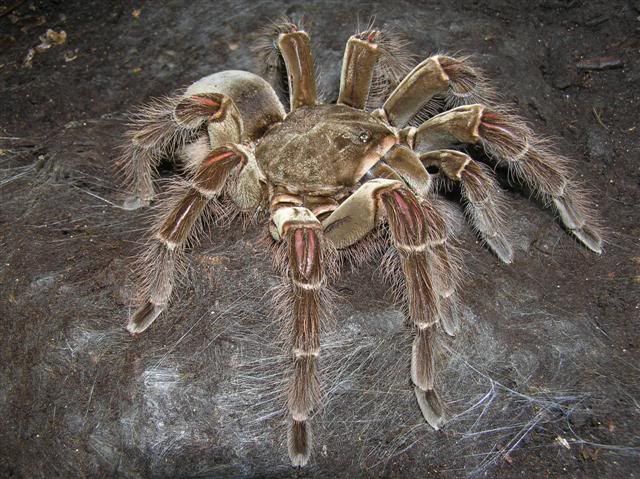
Theraphosa sp. "Burgundy" Guyana, lacks hair on the patella, males lack tibial apophyses, spiderlings have pink/white tarsi...
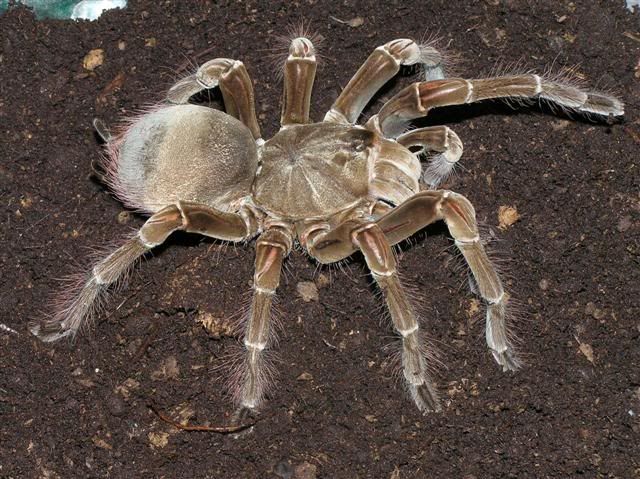
Theraphosa apophysis, Venezuela, hair on patella is present, tibial apophyses are present in males, spiderlings have pink tarsi...
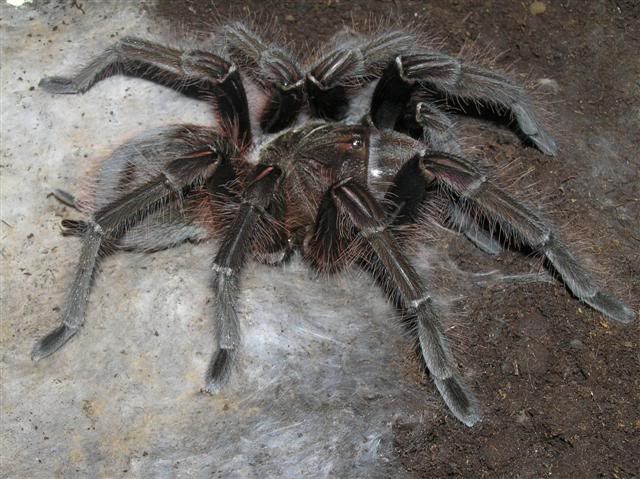
Theraphosa apophysis males are a brilliant purple when they mature as well...
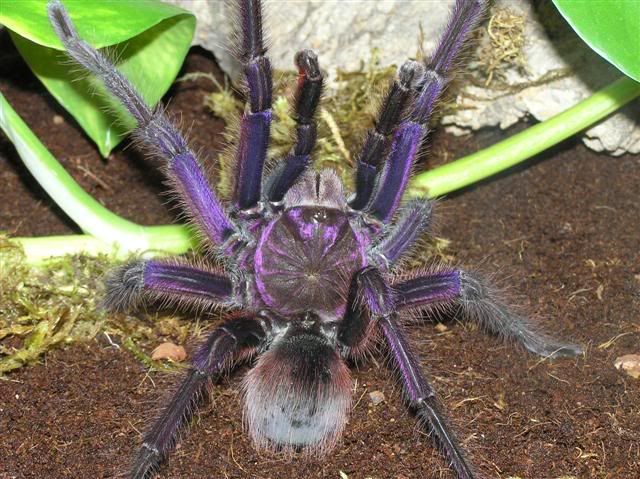
Seems kind of simple now dosent it?
Later, Tom
- Joined
- Nov 8, 2007
- Messages
- 1,533
Theraphosa blondi ALSO lives in Venezuela 
- Joined
- Jan 4, 2003
- Messages
- 2,718
yea but I heard those have green feetTheraphosa blondi ALSO lives in Venezuela
